Understanding Residential Occupant Cooling Behaviour through Electricity Consumption in Warm-Humid Climate
Abstract
1. Introduction
2. Methodology
2.1. Environmental Stress Index (ESI) Analysis
2.2. Residential Energy Demand Monitoring: Auroville
2.2.1. Citadines
2.2.2. Inspiration
2.3. Data Collection
2.4. Limitations
- Blink meter-based monitoring: the electricity meter usually shows an alternating current (AC) static energy (Wh) consumption of the household, and there is an external light-emitting diode (LED) which “blinks” each time a certain amount of energy is consumed. The single-phase meters were of 16,000 blinks/kWh specification, i.e., 0.06 Wh/blink. In the case of three-phase meters, the blink resolution was 800 blinks/kWh (1.25 Wh/blink). Temporally precise electricity consumption was monitored in each candidate dwelling using blink meters mounted on top of the LED lights. Due to the characteristics of the blink meters, the blink depends on the amount of electricity consumed. For example, in the case of single-phase meters, the data are registered when at least 0.06 Wh was consumed, and one blink occurred; values lower than that would not be visible, and the system will wait to blink until it consumes a minimum 0.06 Wh. As a result, two days of the same household would have a different timestamp. The irregular timestamps made the aggregation or generalization of demand profile for further analysis a challenge without data transformation.
- Load shedding: there were regular instances of load shedding—deliberate shutdown in part or parts of a power-distribution system to relieve stress on an electricity grid when demand is higher than the supply—in the monitored buildings. Also, the frequency and duration of the load shedding were not homogenous. To counter the issue of load shedding, some buildings in Auroville uses on-site small diesel generators for electricity.
- Technical issues: the local cellular gateway was also subject to periodic interruptions due to load shedding, which caused gaps in the data collected. In some cases, the network was disconnected due to maintenance by the utility and service provider. The cellular network companies raised another challenge. There were two separate sim-cards for the buildings. As there was lack of specific data plans for the only Internet of things (IoT) systems, the SIM-cards were used with regular data plans, which automatically switch off the service after several months as there were no incoming or outgoing calls in those SIM-cards.
- Human factors: another major constraint was the human-related factors of people disconnecting power to the cellular gateway connected to the blink meters unknowingly, which caused missing data issues without notifying the project partners. In some cases, the residents of the monitored buildings connected temporary lights in shared spaces to the power plug for the cellular gateway. The project partners had to disconnect the temporary connections and restart the data collection.
2.5. Missing Data Filling
- Step 1—Recording missing values: This step involved recording missing data points in the raw data by assigning a timestamp and a “Nan” value.
- Step 2—Recording repeating values: Quite often, raw data contained repeating entries; our algorithm recorded up to 3 consecutive repeating values and removed them to retain a consistent equidistance time series.
- Step 3—Counting the total number of missing points: This step helped in assessing the overall quality check of raw data and was essential to account for the reliability of the analysis and results. For the present study, most of the dataset had a missing point within the 5–10% range.
- Step 4—Logical framework for replacing missing values while retaining periodic components: this was achieved as part of a logical argument that electricity consumption patterns remained consistent (with a small element of randomness) over the different weeks due to similar routines and weekly activity patterns. For example, the consumption at a specific time of the day (say, 9:00 a.m.) for a specific day type (say, Monday) should fluctuate within the close vicinity to values noted at the similar time and day type on following or a previous week. The logical framework was implemented as an iterative procedure.
- Step 5—Infilling missing values in week 1: this step strategically replaced the missing values in the first week using the data from the following week. The missing value was maybe also missing in the 2nd week. In such cases, the algorithm was designed to move forward and scan week 3 to find the relevant value. The process was repeated until all missing data points are infilled in week 1.
- Step 6—Infilling missing values from Week 2 to the end of the dataset: this step replaced the missing values using the data from the preceding weeks. Following the same analogy as in Step 5 if the missing value was also missing in the subsequent week. In such cases, the algorithm was designed to move forward and scan the week after to find the relevant value. The process was repeated until all missing data points were infilled in the week.
- Step 7—Ensuring all missing data points were infilled: to ensure all the missing values were infilled in step 5 and 6, the algorithm checked the total number of Nan values. If there were remaining missing values, step 5 and 6 were iteratively run for up to 10 runs (depending on the length of the data set). The iterative process automatically stopped when all the missing data were infilled.
- Step 8—Final checks: at the end of the iterative process, the algorithm printed the total number of missing values left after ten iterations. Step 8 was essential as in some rare cases, even after ten iterations, some missing points remain. This happened when the value for a particular time/day was consistently missing throughout the dataset. In such cases, users were informed with the remaining number of missing data points which could be infilled by the user (case-by-case) using some other techniques/logical basis and depending on the nature of the study.
3. Results and Discussion
3.1. Climate: Auroville
3.2. Electricity Consumption Pattern in Monitored Households with Single-Phase Meters
3.3. Developing a Weekly Profile without Missing Data
3.4. Electricity Consumption Analysis for Comfort in the Selected Household
4. Conclusions
Supplementary Materials
Author Contributions
Funding
Acknowledgments
Conflicts of Interest
References
- World Bank. World Development Indicators (WDI). 2019. Available online: http://databank.worldbank.org/data/source/world-development-indicators (accessed on 10 November 2019).
- United Nations. World Population Prospects 2019. United Nations, 2019. Available online: https://population.un.org/wpp/Graphs/Probabilistic/POP/TOT/156 (accessed on 1 November 2019).
- Government of India. HOUSING—Statistical Year Book India 2017. Ministry of Statistics & Programme Implementation, 2017. Available online: http://mospi.nic.in/statistical-year-book-india/2017/197 (accessed on 25 November 2019).
- World Economic Forum. Future of Consumption in Fast-Growth Consumer Markets: INDIA; WEF: Cologny, Switzerland, 2019. [Google Scholar]
- Sivak, M. Potential energy demand for cooling in the 50 largest metropolitan areas of the world: Implications for developing countries. Energy Policy 2009, 37, 1382–1384. [Google Scholar] [CrossRef]
- Sustainable Energy for All. Chilling Prospects: Providing Sustainable Cooling for All; Sustainable Energy for All: Vienna, Austria, 2018. [Google Scholar]
- IEA. Energy Efficiency: Cooling. International Energy Agency, 2019. Available online: https://www.iea.org/topics/energyefficiency/buildings/cooling/ (accessed on 1 November 2019).
- Government of India. India Cooling Action Plan; Government of India: New Delhi, India, 2019.
- Mastrucci, A.; Byers, E.; Pachauri, S.; Rao, N.D. Improving the SDG energy poverty targets: Residential cooling needs in the Global South. Energy Build. 2019, 186, 405–415. [Google Scholar] [CrossRef]
- Government of India. India Energy Security Scenarios 2047. Government of India, 2015. Available online: http://iess2047.gov.in (accessed on 1 November 2019).
- Abhyankar, N.; Shah, N.; Park, W.Y.; Phadke, A. Accelerating Energy Efficiency Improvements in Room Air Conditioners in India: Potential, Costs-Benefits, and Policies; Ernest Orlando Lawrence Berkeley National Laboratory: Berkeley, CA, USA, 2017.
- Murthy, K.N.; Sumithra, G.D.; Reddy, A.K. End-uses of electricity in households of Karnataka state, India. Energy Sustain. Dev. 2001, 5, 81–94. [Google Scholar] [CrossRef]
- Filippini, M.; Pachauri, S. Elasticities of electricity demand in urban Indian households. Energy Policy 2004, 32, 429–436. [Google Scholar] [CrossRef]
- Van Ruijven, B.; Van Vuuren, D.P.; De Vries, B.J.; Isaac, M.; Van Der Sluijs, J.P.; Lucas, P.; Balachandra, P. Model projections for household energy use in India. Energy Policy 2011, 39, 7747–7761. [Google Scholar] [CrossRef]
- Dhar, S.; Srinivasan, B.; Srinivasan, R. Simulation and Analysis of Indian Residential Electricity Consumption Using Agent-Based Models. Softw. Archit. Tools Comput. Aided Process Eng. 2018, 43, 205–210. [Google Scholar]
- Al-Homoud, M.S. Computer-aided building energy analysis techniques. Build. Environ. 2001, 36, 421–433. [Google Scholar] [CrossRef]
- Vartholomaios, A. A parametric sensitivity analysis of the influence of urban form on domestic energy consumption for heating and cooling in a Mediterranean city. Sustain. Cities Soc. 2017, 28, 135–145. [Google Scholar] [CrossRef]
- Räsänen, T.; Voukantsis, D.; Niska, H.; Karatzas, K.; Kolehmainen, M. Data-based method for creating electricity use load profiles using large amount of customer-specific hourly measured electricity use data. Appl. Energy 2010, 87, 3538–3545. [Google Scholar] [CrossRef]
- He, D.; Lin, W.; Liu, N.; Harley, R.G.; Habetler, T.G. Incorporating Non-Intrusive Load Monitoring Into Building Level Demand Response. IEEE Trans. Smart Grid 2013, 4, 1870–1877. [Google Scholar]
- Widén, J.; Lundh, M.; Vassileva, I.; Dahlquist, E.; Ellegård, K.; Wäckelgård, E. Constructing load profiles for household electricity and hot water from time-use data—Modelling approach and validation. Energy Build. 2009, 41, 753–768. [Google Scholar] [CrossRef]
- Reddy, T.A. Literature review on calibration of building energy simulation programs: Uses, problems, procedures, uncertainty, and tools. ASHRAE Trans. 2006, 112, 226. [Google Scholar]
- Wang, S.; Yan, C.; Xiao, F. Quantitative energy performance assessment methods for existing buildings. Energy Build. 2012, 55, 873–888. [Google Scholar] [CrossRef]
- Yu, Z.; Fung, B.C.; Haghighat, F.; Yoshino, H.; Morofsky, E. A systematic procedure to study the influence of occupant behavior on building energy consumption. Energy Build. 2011, 43, 1409–1417. [Google Scholar] [CrossRef]
- Hong, T.; Taylor-Lange, S.C.; D’Oca, S.; Yan, D.; Corgnati, S.P. Advances in research and applications of energy-related occupant behavior in buildings. Energy Build. 2016, 116, 694–702. [Google Scholar] [CrossRef]
- Yan, D.; O’Brien, W.; Hong, T.; Feng, X.; Gunay, H.B.; Tahmasebi, F.; Mahdavi, A. Occupant behavior modeling for building performance simulation: Current state and future challenges. Energy Build. 2015, 107, 264–278. [Google Scholar] [CrossRef]
- Moran, D.; Pandolf, K.; Shapiro, Y.; Heled, Y.; Shani, Y.; Mathew, W.; Gonzalez, R. An environmental stress index (ESI) as a substitute for the wet bulb globe temperature (WBGT). J. Therm. Boil. 2001, 26, 427–431. [Google Scholar] [CrossRef]
- AF. Auroville in Brief. Auroville Foundation, 2017. Available online: https://www.auroville.org/contents/95 (accessed on 1 November 2019).
- AF. Auroville Green Practices. Auroville Foundation, 2020. Available online: http://www.green.aurovilleportal.org/ (accessed on 1 November 2019).
- Kundoo, A. Auroville: An Architectural Laboratory. Arch. Des. 2007, 77, 50–55. [Google Scholar] [CrossRef]
- Kapoor, R. Auroville: A spiritual-social experiment in human unity and evolution. Future 2007, 39, 632–643. [Google Scholar] [CrossRef]
- Nagy, B. Experimented methods to moderate the impact of climate change in Auroville. Ecocycles 2018, 4, 20–31. [Google Scholar] [CrossRef]
- Loret, S.L.; Martin, S.; Sarkhot, D. Sustainable Energy in Auroville The Vision and the Reality; Indian Institute of Technology Madras: Auroville, India, 2002. [Google Scholar]
- Google Maps. Map Showing the Location of Auroville. Google, 2019. Available online: https://www.google.com/maps (accessed on 1 November 2018).
- Dumedah, G.; Coulibaly, P. Evaluation of statistical methods for infilling missing values in high-resolution soil moisture data. J. Hydrol. 2011, 400, 95–102. [Google Scholar] [CrossRef]
- Khalil, M.; Panu, U.S.; Lennox, W.C. Groups and neural networks based streamflow data infilling procedures. J. Hydrol. 2001, 241, 153–176. [Google Scholar] [CrossRef]
- Coulibaly, P.; Evora, N. Comparison of neural network methods for infilling missing daily weather records. J. Hydrol. 2007, 341, 27–41. [Google Scholar] [CrossRef]
- Gelman, A.; Hill, J. Data Analysis Using Regression and Multilevel/Hierarchical Models by Andrew Gelman; Cambridge University Press: Cambridge, UK, 2006. [Google Scholar]
- Climate-Data. Auroville Climate. 2020. Available online: https://en.climate-data.org/asia/india/tamil-nadu/auroville-31587/ (accessed on 1 January 2020).
- Weather Spark. Average Weather in Auroville. Cedar Lake Ventures. 2020. Available online: https://weatherspark.com/y/109814/Average-Weather-in-Auroville-India-Year-Round (accessed on 1 January 2020).
- Synergy Enviro Engineers. Solar Irradiance (Puducherry). Synergy Enviro Engineers, 2020. Available online: http://www.synergyenviron.com/tools/solar-irradiance/india/puducherry/puducherry (accessed on 1 January 2020).
- Fan, H.; MacGill, I.; Sproul, A. Statistical analysis of drivers of residential peak electricity demand. Energy Build. 2017, 141, 205–217. [Google Scholar] [CrossRef]
- Vyas, D.; Apte, M. Effectiveness of Natural and Mechanical Ventilative Cooling in Residential Building in Hot & Dry and Temperate Climate of India. In Proceedings of the 33rd PLEA International Conference: Design to Thrive (PLEA 2017), Edinburgh, UK, 2–5 July 2017. [Google Scholar]
- He, Y.; Chen, W.; Wang, Z.; Zhang, H. Review of fan-use rates in field studies and their effects on thermal comfort, energy conservation, and human productivity. Energy Build. 2019, 194, 140–162. [Google Scholar] [CrossRef]
- Rijal, H.B.; Humphreys, M.; Nicol, F. Understanding occupant behaviour: The use of controls in mixed-mode office buildings. Build. Res. Inf. 2009, 37, 381–396. [Google Scholar] [CrossRef]
- Indraganti, M. Behavioural adaptation and the use of environmental controls in summer for thermal comfort in apartments in India. Energy Build. 2010, 42, 1019–1025. [Google Scholar] [CrossRef]
- McCallum, P.; Jenkins, D.; Peacock, A.D.; Patidar, S.; Andoni, M.; Flynn, D.; Robu, V. A multi-sectoral approach to modelling community energy demand of the built environment. Energy Policy 2019, 132, 865–875. [Google Scholar] [CrossRef]
- CEDRI. Community-Level Energy Demand Reduction (CEDRI) Project. 2018. Available online: www.cedri.hw.ac.uk (accessed on 1 June 2019).
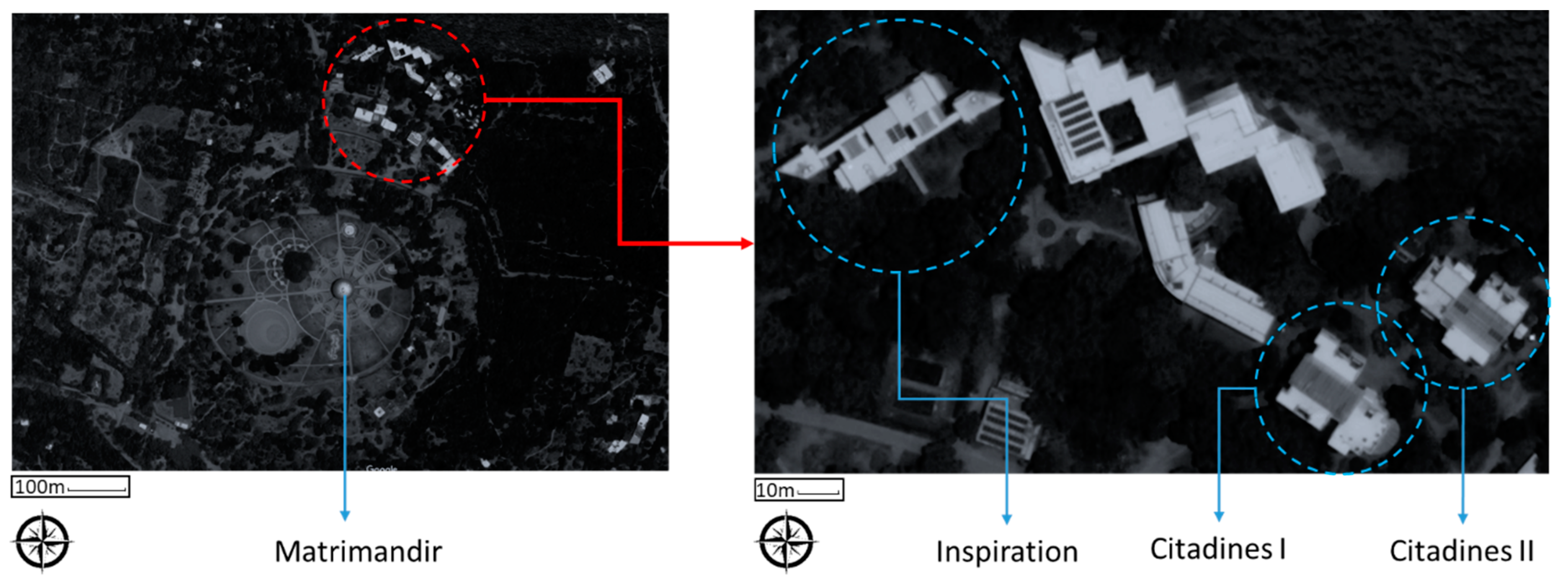
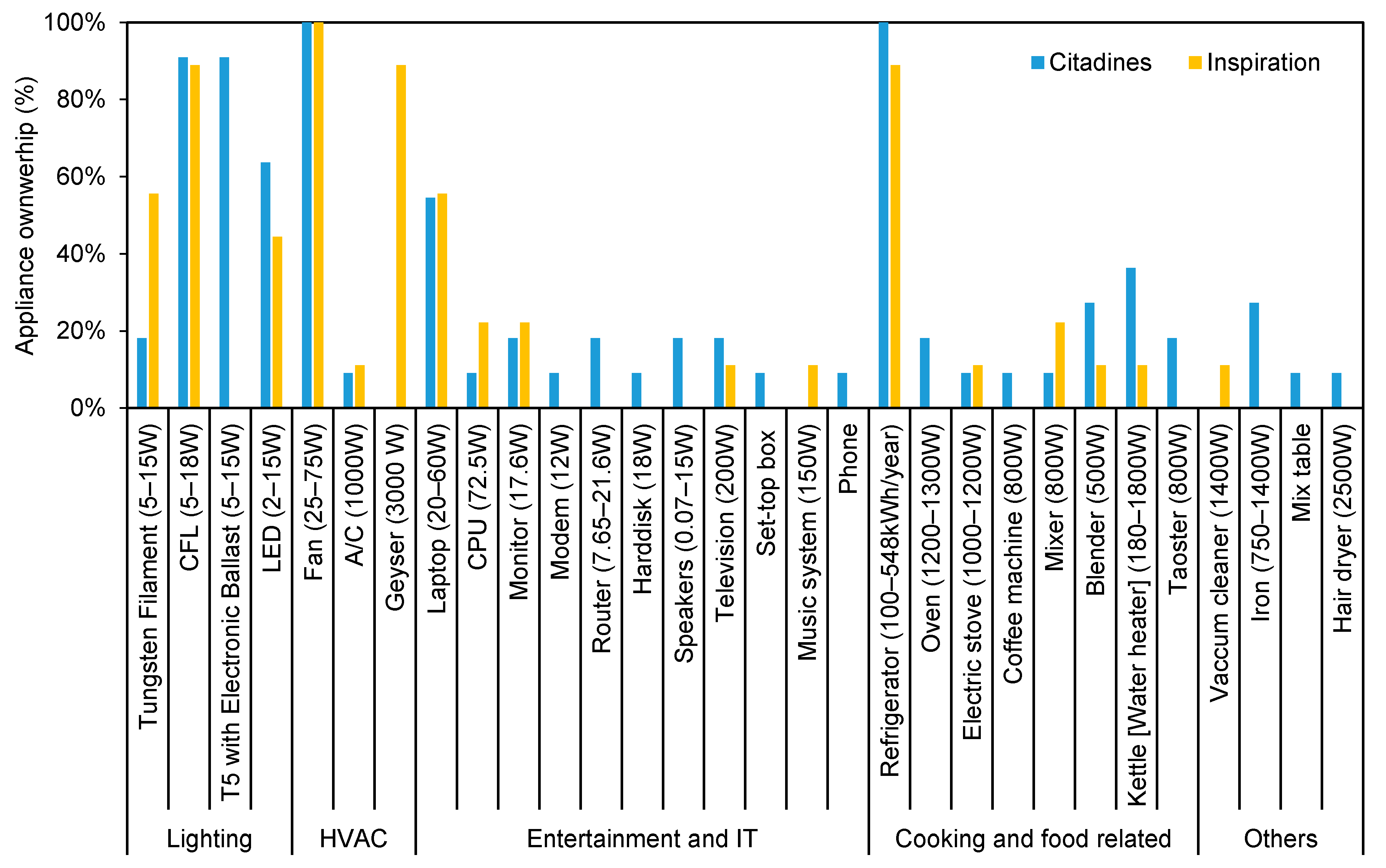
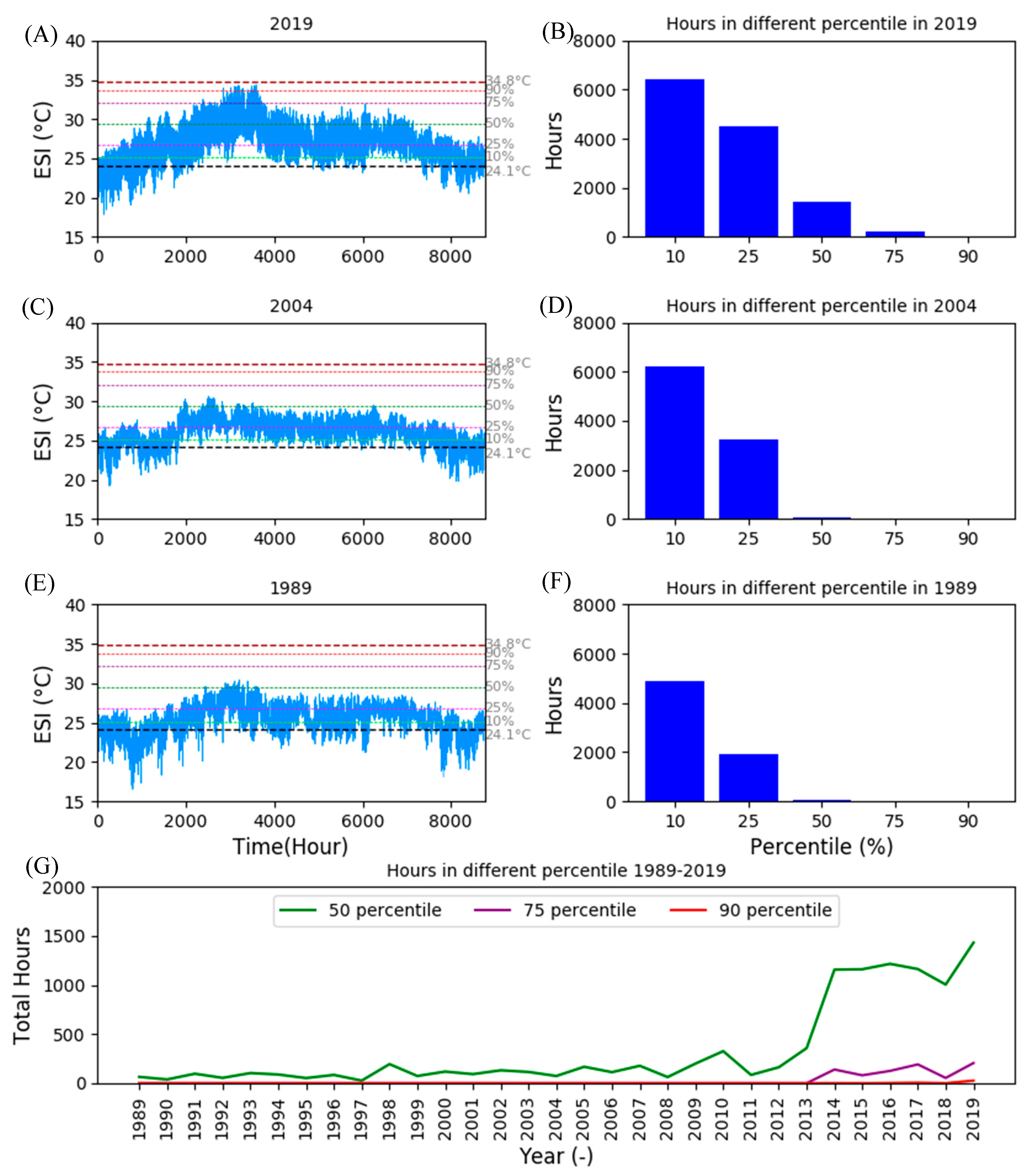
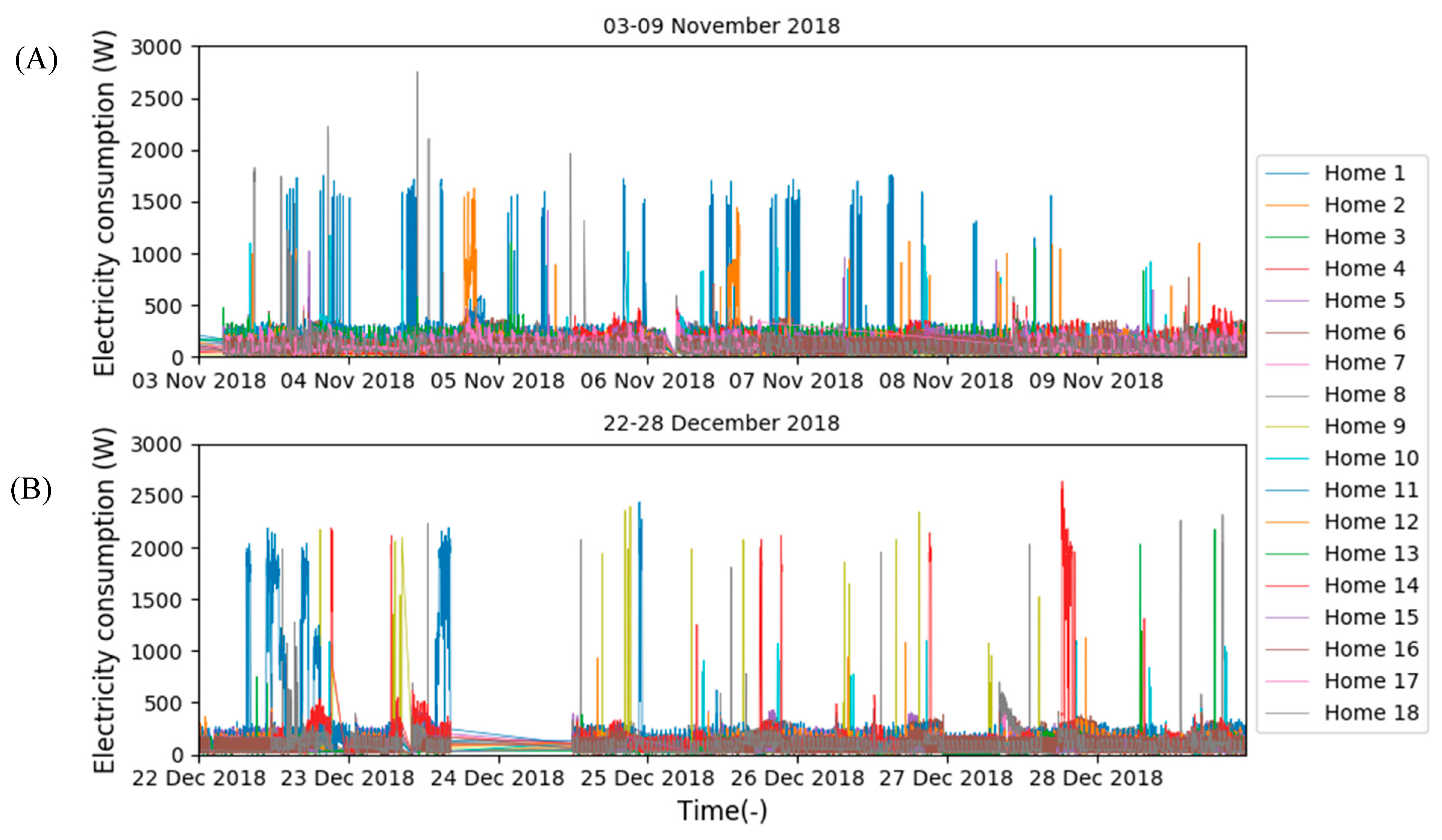
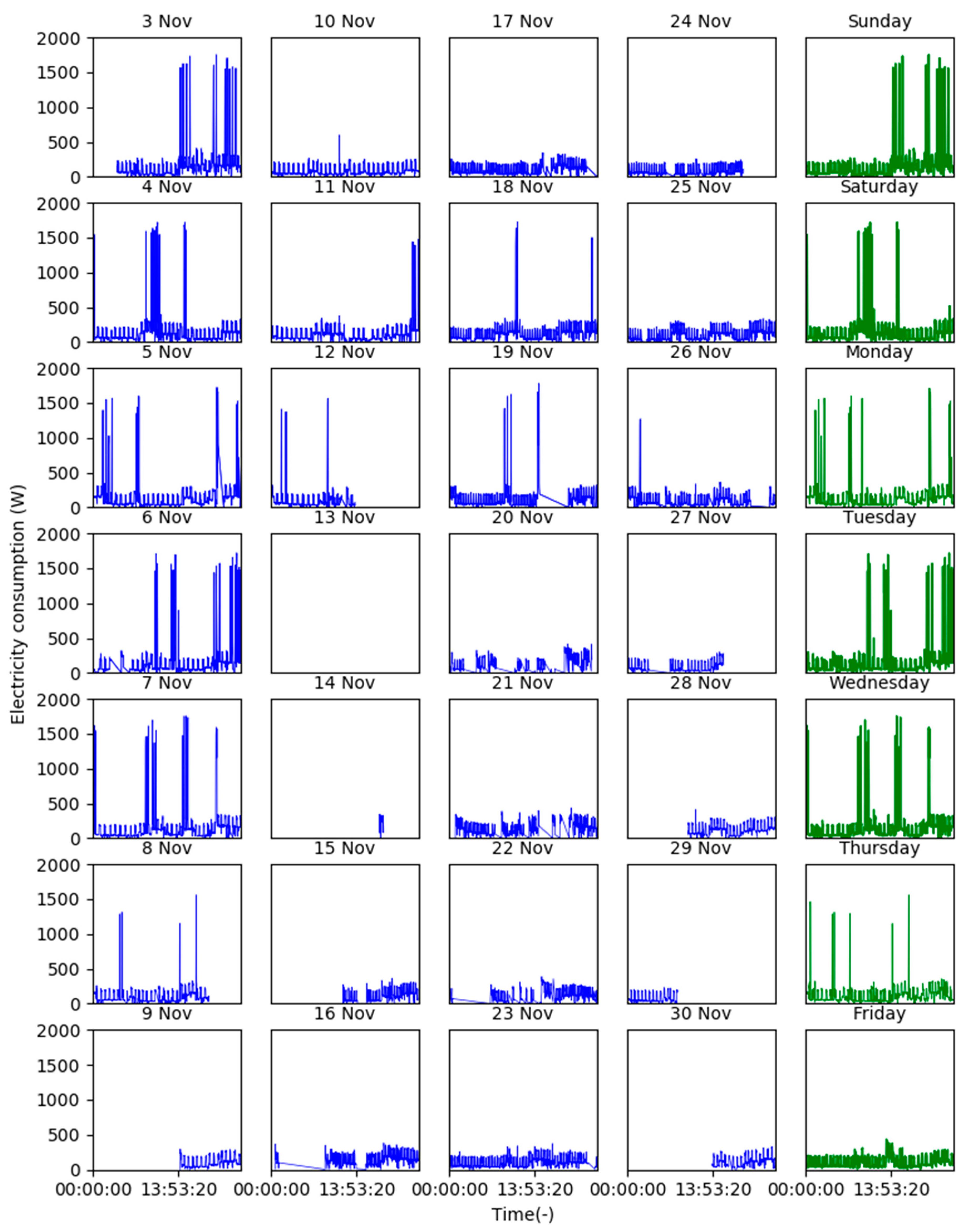
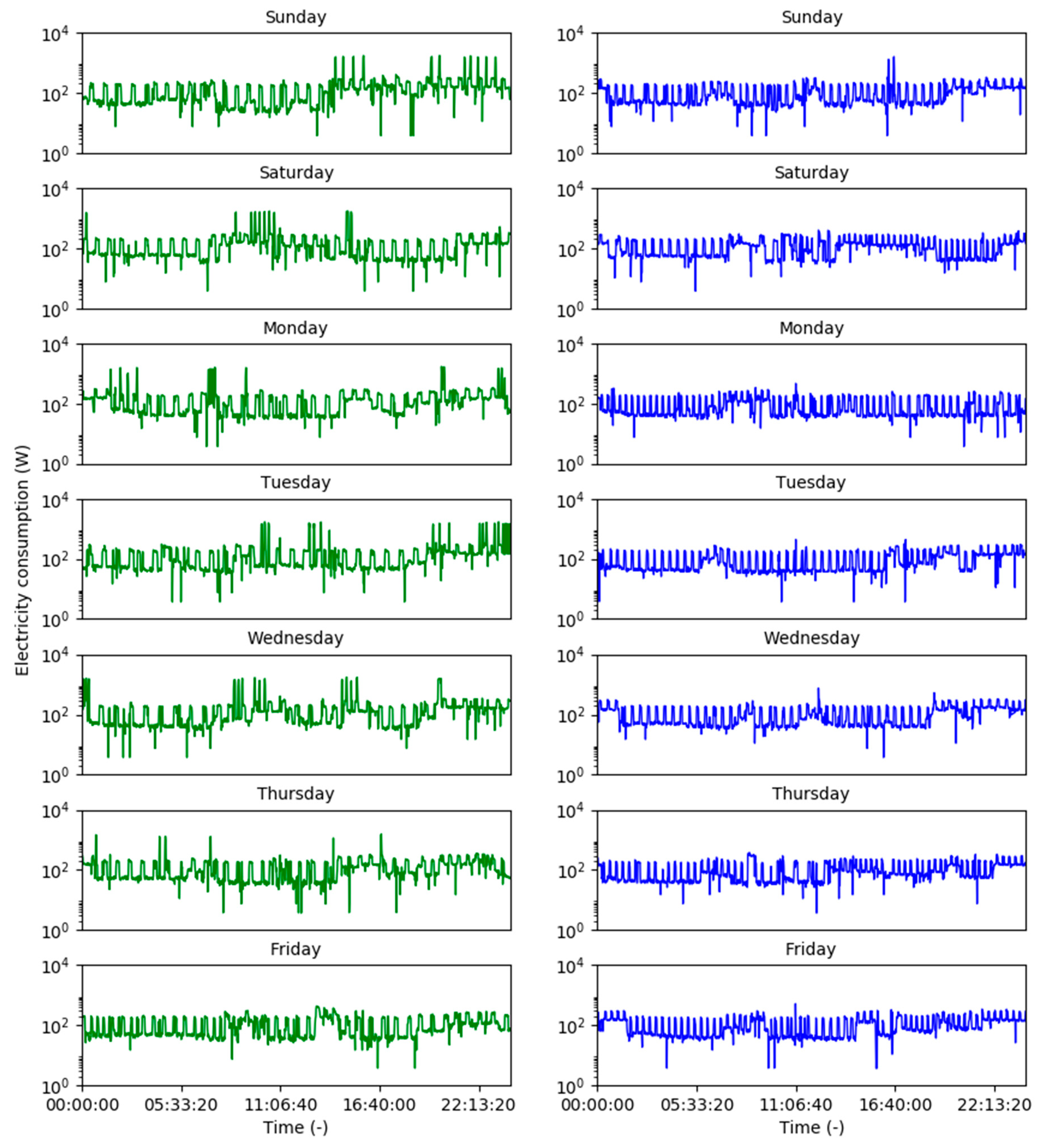
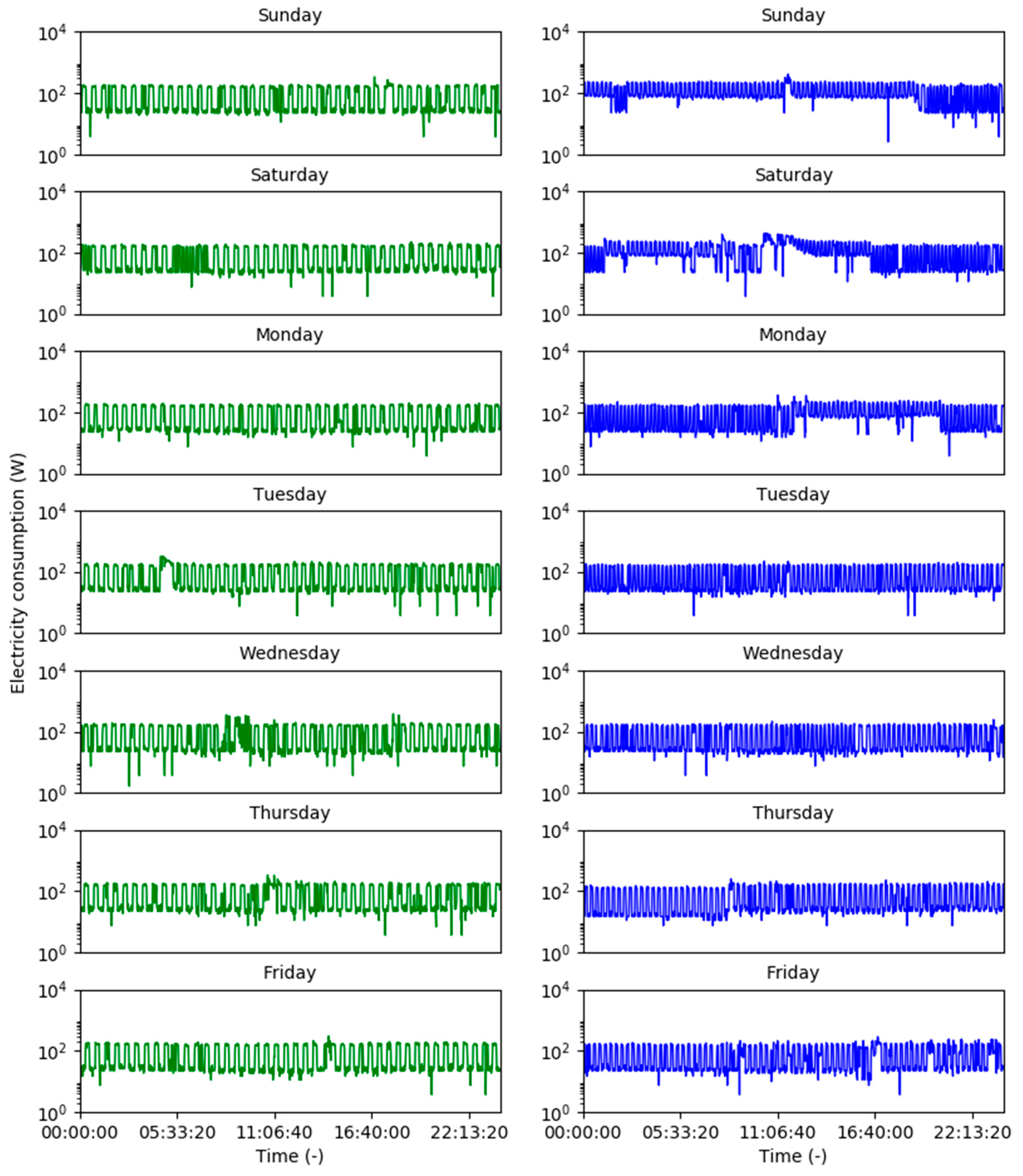
© 2020 by the authors. Licensee MDPI, Basel, Switzerland. This article is an open access article distributed under the terms and conditions of the Creative Commons Attribution (CC BY) license (http://creativecommons.org/licenses/by/4.0/).
Share and Cite
Debnath, K.B.; Jenkins, D.P.; Patidar, S.; Peacock, A.D. Understanding Residential Occupant Cooling Behaviour through Electricity Consumption in Warm-Humid Climate. Buildings 2020, 10, 78. https://doi.org/10.3390/buildings10040078
Debnath KB, Jenkins DP, Patidar S, Peacock AD. Understanding Residential Occupant Cooling Behaviour through Electricity Consumption in Warm-Humid Climate. Buildings. 2020; 10(4):78. https://doi.org/10.3390/buildings10040078
Chicago/Turabian StyleDebnath, Kumar Biswajit, David P. Jenkins, Sandhya Patidar, and Andrew D. Peacock. 2020. "Understanding Residential Occupant Cooling Behaviour through Electricity Consumption in Warm-Humid Climate" Buildings 10, no. 4: 78. https://doi.org/10.3390/buildings10040078
APA StyleDebnath, K. B., Jenkins, D. P., Patidar, S., & Peacock, A. D. (2020). Understanding Residential Occupant Cooling Behaviour through Electricity Consumption in Warm-Humid Climate. Buildings, 10(4), 78. https://doi.org/10.3390/buildings10040078






